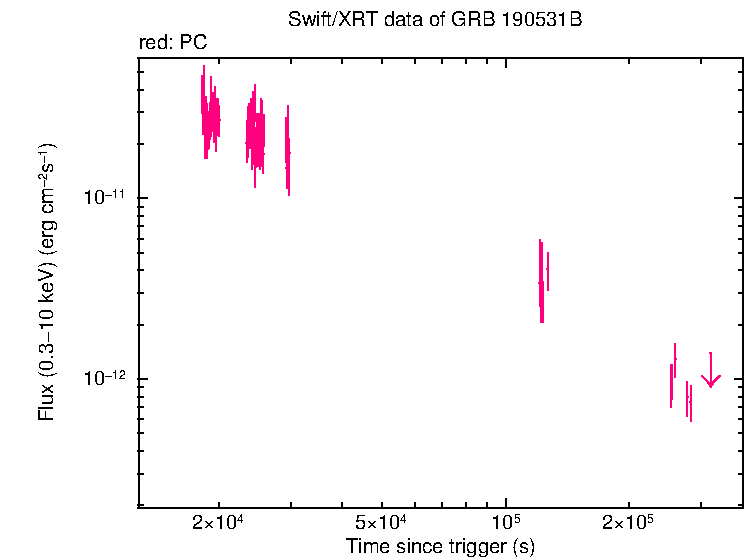
P. D'Avanzo (INAF-OAB) and K.K. Simpson (PSU) for the Swift team
Axelsson et al. (GCN Circ. 24701) reported the GRB detection. Table 1 contains the best reported positions from Swift.
Table 2 is a summary of GCN Circulars about this GRB from observatories other than Swift.
BAT did not observe this burst.
Analysis of the initial XRT data was reported by D'Avanzo et al. (GCN Circ. 24706).
The light curve (Figure 2) can be modelled with a power-law decay with a decay index of α=1.0 ± 0.3.
A spectrum formed from the PC mode data can be fitted with an absorbed
power-law with a photon spectral index of 2.20 (+0.15, -0.14). The
best-fitting absorption column is 9.1 (+1.2, -1.1) x 1
The Swift/UVOT began settled observations
(Simpson GCN Circ. 24731) of the field of GRB 190531B 18175 s after the LAT trigger (Axelsson et al., GCN Circ. 24701).
No optical afterglow consistent with the XRT position (D'Avanzo et al., GCN Circ. 24706) is detected in the initial UVOT exposures.
Table 3 gives preliminary
magnitudes using the UVOT photometric system
(Breeveld et al. 2011, AIP Conf. Proc., 1358, 373).
No correction has been made for the expected extinction in the Milky Way
corresponding to a reddening of
Figure 1. The BAT light curve is not available.

Figure 2. The XRT light curve.
Any data from a crosshatched region are not included in the fit.
| RA (J2000) | Dec (J2000) | Error | Note | Reference |
|---|---|---|---|---|
| 0 |
-41°57'30.3" | 1.6" | XRT-final | UKSSDC |
| 0 |
-41°57'30.3" | 1.6" | XRT | D'Avanzo et al. GCN Circ. 24706 |
| Band | Authors | GCN Circ. | Subject | Observatory | Notes |
|---|---|---|---|---|---|
| Optical | Lipunov et al. | 24707 | MASTER optical observation | MASTER | |
| Optical | Japelj et al. | 24711 | VLT optical upper limit | VLT | upper limits |
| Gamma-ray | Fermi | 24695 | Fermi GBM Final Real-time Localization | Fermi GBM | |
| Gamma-ray | Axelsson et al. | 24701 | Fermi-LAT detection | Fermi LAT | |
| Gamma-ray | Veres and Meegan | 24705 | Fermi GBM observations | Fermi GBM | Fluence=9.91±0.08x1 (97.8 percentile for long GRBs) |
| Gamma-ray | Yi et al. | 24713 | Insight-HXMT/HE detection | Insight-HXMT | |
| Gamma-ray | Svinkin et al. | 24730 | Konus-Wind observation | Konus-Wind | Duration=~110 seconds Fluence=1.51(-0.15,+0.16)x1 |
| Gamma-ray | Shimizu et al. | 24738 | CALET Gamma-Ray Burst Monitor detection | CALET |
| Filter | Exp(s) | Mag | ||
|---|---|---|---|---|
| b | 18661 | 24137 | 365 | >20.5 |
| u | 18497 | 29702 | 551 | >21.1 |
| w1 | 18175 | 29509 | 1132 | >20.7 |
| m2 | 19630 | 25766 | 972 | >20.9 |
| w2 | 18826 | 24990 | 1459 | >21.3 |
Table 3. UVOT observations reported by Simpson (GCN Circ. 24731). The start and stop times of the exposures are given in seconds since the BAT trigger. The preliminary 3-σ upper limits are given. No correction has been made for extinction in the Milky Way.
June 5, 2019